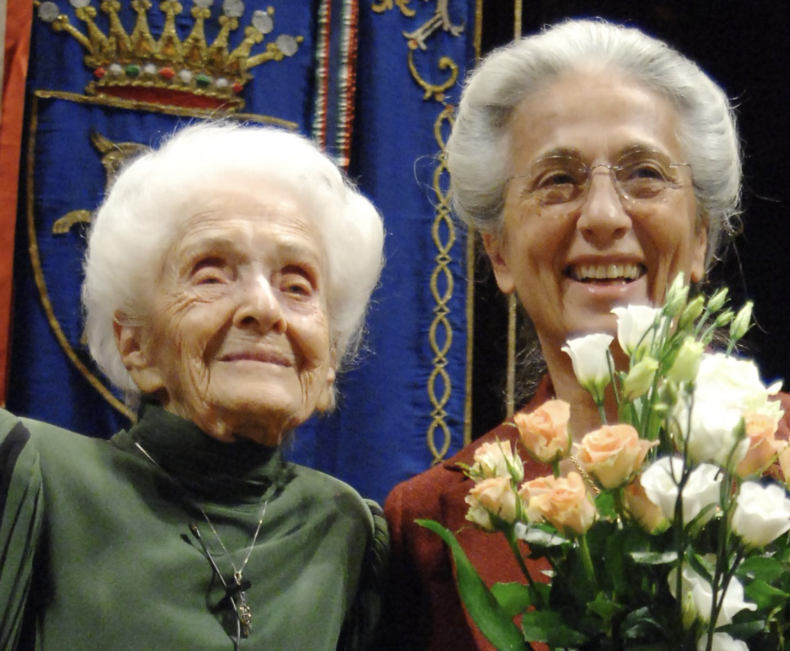Patient work to read the hundreds of letters Rey, as they called Rita Levi-Montalcini when she was a child, had sent to her family. Above all are letters to his father Adamo, an engineer who moved from Turin to Bari to design ice plants, as well as correspondence with the brothers Gino and Anna and their twin sister Paola. An enormous heritage of documents, to which have been added photographs, report cards, newspapers of the time, objects that tell a personal story, but which also form an important part of the Italian twentieth century. To remember Aunt Rita on the tenth anniversary of her death, her niece Pira Levi-Montalcini worked. At Hand, she relives the famous scientist’s childhood, reconstructing the path that led her from a secret laboratory in Turin in the 1940s to extraordinary discoveries and conquering – the first and currently only Italian woman – Nobel. A book was born signed with Alberto Capio, responsible for the research activities of the Levi-Montalcini family archive. The volume is titled A Dream Under a Microscope. Rita Levi-Montalcini’s Journey to the Nobel Prize. It is aimed at children and opens with a few sentences which are already a small lesson in themselves. “Those who study know that they will never win, even if they are given the Nobel Prize. But they also know that they cannot lose.” And again: “The head. There is someone who lowers it, and someone who hides it, and someone who loses it. I prefer the one who uses it. Or: “I believe in morality, without it life is worth nothing, not even to live it.” The aphorisms that sum up the thought of the artist of science, as defined by her granddaughter, and of which there is still much to discover. A legacy that Piera Levi-Montalcini attempts to spread through editorial projects, work with schools, and research initiatives. As he explained to Pagine Ebraiche, he would also like it to be organized into a real study center.
What was it like restoring the family archive?
Wonderful trip. There is a huge number of letters written by children to their father and to each other. We are talking about three thousand documents, ranging from the 1920s to the 1930s with a gap and then from the war period. Taking those papers brought me back in my hands many pieces of history at the time and obviously family history. What stands out is the deep bond, affection, and complicity between parents and siblings who have remained resilient despite hard times, the violence of racial laws, and war. In the darkness of a period of conflict and persecution, there is, for example, a letter that Aunt Rita, who no longer has any information on anyone, sends to a bank where she learns that the two brothers have a checking account and asks him to. hand it over to them. In the letter there is all the pathos of the aunt saying “I don’t know anything about you anymore, I don’t know if you’re alive, I don’t know if you’re dead or not. Know what happened to you, and let me know””.
Are there any undiscovered fragments in the archives of these letters?
Definitely. I have only read a part, but everything is to be studied and appreciated. Because then comes some good like Aunt Rita who gives her a high school diploma by sewing a women’s shirt. And one imagines how a future Nobel Prize winner might take an exam of this kind and better understand not only her character, but the historical context in which she moved, and the difficulties she faced.
The book also features a portrait of a young Levi Montalcini who is having some difficulties at school.
Yes, Rita has had her ups and downs too, and we were amazed to discover on her middle school report card that she had a top five. It’s an important example for young people: We don’t always find our way right away. And after all, my aunt had not known for a long time what kind of future she had to create for herself. And she was the last to become famous: for a long time Abi and Aunt Paula were the famous faces of the family. One is in all books on architecture, and the other is on display everywhere in art galleries. But my father knew that Aunt Rita would succeed.
She was a science artist.
So the bond between the brothers was strong. Could it be a subject of study?
It was a family where there was a lot of talk. And there is a legacy of Levi-Montalcini-related exchanges and materials that I would like to appreciate. They must be collected systematically and my dream is to create a study center dedicated to Aunt Rita, but also to the relationship with her siblings: be it in Turin, Saint Louis or in Israel. Any place is fine for me, as long as you make that place where you can work in the world of the whole family: I would also take my father’s furniture there, for example, not only the papers, because they are part of the world of the past that will never return. Among other things, I am convinced that everyone should recover their family stories, things from the past and create their own archive. Because there will come a day when everything will be forgotten. Alternatively we can create a network of linked archives of materials. I think, for example, of all the relationships my aunt had in the United States with the many Jews who, like her, were forced to flee Nazi-fascist Europe. There will certainly be messages and exchange on this subject. And you imagine the interest of connecting everything.
There is still much affection about Rita Levi-Montalcini. She has built a network with her aunt’s designated schools and is committed to promoting scientific research. Are there any other projects in the pipeline?
My aunt, who is 101 years old, told me, “If what I believe is true, I will get a second Nobel Prize.” Unfortunately, he died the following year, but in the drawer of my mind this idea was still preserved. And now I’m looking for a research group that can go further.
Daniel Richell
(December 18, 2022)

“Infuriatingly humble social media buff. Twitter advocate. Writer. Internet nerd.”



